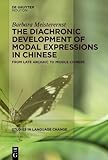The Diachronic Development of Modal Expressions in Chinese : From Late Archaic to Middle Chinese / Barbara Meisterernst.
Material type: TextSeries: Studies in Language Change [SLC] ; 18Publisher: Berlin ; Boston : De Gruyter Mouton, [2024]Copyright date: 2025Description: 1 online resource (XIII, 372 p.)Content type:
TextSeries: Studies in Language Change [SLC] ; 18Publisher: Berlin ; Boston : De Gruyter Mouton, [2024]Copyright date: 2025Description: 1 online resource (XIII, 372 p.)Content type: - 9783110737783
- 9783110733037
- 9783110733013
- 495.109
- online - DeGruyter
- Issued also in print.
| Item type | Current library | Call number | URL | Status | Notes | Barcode | |
|---|---|---|---|---|---|---|---|
 eBook
eBook
|
Biblioteca "Angelicum" Pont. Univ. S.Tommaso d'Aquino Nuvola online | online - DeGruyter (Browse shelf(Opens below)) | Online access | Not for loan (Accesso limitato) | Accesso per gli utenti autorizzati / Access for authorized users | (dgr)9783110733013 |
Frontmatter -- Acknowledgments -- Contents -- Abbreviations -- Introduction -- 1 The different modal categories in Late Archaic and Early Middle Chinese and their realization -- 2 The diachronic development of deontic modals in Early Middle Chinese -- 3 Modality and future marking in Late Archaic and Middle Chinese -- 4 Postverbal modals: The case of De -- 5 More on negation and polarity -- 6 A brief overview on the cross-linguistic development of modals -- Conclusion -- References -- Index
restricted access online access with authorization star
http://purl.org/coar/access_right/c_16ec
The present study is the first to apply a syntactic approach to the grammaticalization of Chinese modals, based on hypotheses on cross-linguistic diachronic developments of modals from lexical to functional categories as upward movement on a functional spine. The temporal framework of the study covers Late Archaic and Middle Chinese. Early Middle Chinese is a crucial turning point for the development of Chinese from a more synthetic to a more analytic language. This change is attributed e.g. to the loss of a former morphology, which also affects the modal system. Against this background, the negative cycle of Chinese, the relevance of polarity contexts, and the development of a new system of deontic, epistemic and future markers are analyzed. In addition to a comprehensive analysis of the syntactic processes involved in the diachronic changes of the Chinese modal system, the study also provides a comparison with the syntax of grammaticalization of the thoroughly discussed Germanic modals. This constitutes a broad basis for further analyses of the changes in the Chinese language during its long written history, but also for cross-linguistic studies on the syntax of grammaticalization and on linguistic universals.
Issued also in print.
Mode of access: Internet via World Wide Web.
In English.
Description based on online resource; title from PDF title page (publisher's Web site, viewed 20. Nov 2024)


